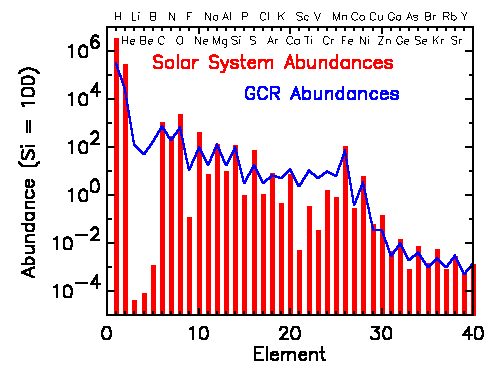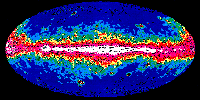Cosmic Rays
Cosmic Rays
Cosmic-ray composition
Cosmic rays are a puzzling form of radiation that is constantly raining down on us from space. They are made up of electrically charged, subatomic particles that crash into our atmosphere, where they are broken up and fall to Earth in even smaller fragments.
Because cosmic rays are electrically charged, they are deflected by various magnetic fields throughout the galaxy. Due to this deflection, the rays don't point directly back to their sources. Scientists must use indirect methods to determine the source of the cosmic rays and the way they have traveled (or "propagated") through the galaxy. The chemical composition of the cosmic rays provide a surprisingly rich source of information. The chemical composition of the solar system has been determined from a combination of spectroscopy on the Sun, studies of the solar wind and by chemical analysis of meteorites. These meteorites likely have a purer sample of the early solar system's components than terrestrial rocks, which have had many years of constant pressure and change here on Earth to distort their original forms.
The composition of cosmic rays is important because these rays are a direct sample of matter from outside the solar system and contain elements that are much too rare to be seen in spectroscopic lines from other stars. They also provide important information on the chemical evolution of the universe.
If we look at the elemental composition measured for cosmic rays and compare it to our best understanding of the composition of the solar system, we quickly see some large differences.
 |
Solar and Galactic Cosmic Ray (GCR) Composition |
Cosmic-ray secondaries
In the figure above, we take the abundance of silicon as a "standard candle" or reference point, and compare the abundances (relative to silicon) of the elements in the solar system and in galactic cosmic rays. Silicon is used as the reference because it is a common intermediate-weight element that is easy to measure. We see that there is less hydrogen and helium in the cosmic rays than in the solar system, we think because hydrogen and helium are harder to accelerate to high energies than heavier elements. We also see that some light elements (lithium, beryllium, and boron) that are rare in the solar system (and in the rest of the universe) are quite common in cosmic rays. We also see more cosmic ray elements between silicon and iron than in the solar system.The accepted reason for all the observed cosmic ray lithium, beryllium, and boron is that these are pieces of heavier cosmic ray elements, especially carbon and oxygen, that have had high speed collisions with the very tenuous gas in interstellar space. Likewise, the elements between silicon and iron have been supplemented by fragments of heavy cosmic rays such as iron and nickel. These fragments are known as secondary cosmic rays, or simply secondaries.
From the number of secondaries observed at Earth, and with knowledge of the probability of these collisions (which can be measured in particle accelerators here on Earth), it is possible to calculate the amount of matter that the cosmic rays have traveled through. More matter would break up more primary cosmic rays. If the cosmic rays have stayed in the galaxy, the amount of matter that they have passed through divided by the average density of interstellar space (about one atom per cubic centimeter) gives the age of cosmic rays. With this method, we determine an average cosmic ray age of about two million years. But this turns out to be inaccurate.
Radioactive clocks
Another way to obtain the age of cosmic rays is to use radioactive isotopes as clocks in a way very similar to the way carbon-14 is used by archaeologists. There are several isotopes, beryllium-10, aluminum-26, chlorine-36, etc., which are almost entirely secondaries. After they are created, they begin to decay, and the fraction that reaches us at Earth gives the age of the cosmic rays. With this method, the average age of cosmic rays comes out to approximately ten million years. The reason the two million year age from the previous paragraph is wrong is that cosmic rays don't just stay in the regions where the density is one atom per cubic centimeter (such as the galactic disk). Cosmic rays spend a large portion of their time in the low-density galactic halo, bouncing back and forth through the galactic disk many times.
 |
EGRET Gamma Ray All Sky Survey |
As the cosmic rays interact with interstellar gas, they can produce gamma rays, which can be seen in the EGRET gamma ray image of the Milky Way galaxy shown above.
Last Modified: March 2011

